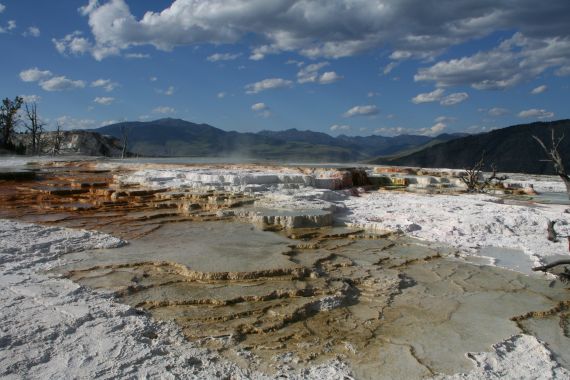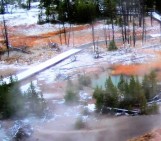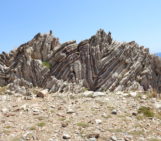Spring waters are rich in minerals, carrying with them dissolved components of the rocks they have travelled through. The water that discharges at Mammoth Hot Springs in Yellowstone National Park is highly alkaline (contains a lot of dissolved CO2) and rich in calcium, but as the water cools, the calcium precipitates to form the white limestone terraces you see here.

“Mammoth Hot Springs” by Gert Verstraeten, distributed by the EU under a Creative Commons licence.
This limestone is known as travertine – a term that encompasses all non-marine limestones – and it forms looping fibrous shelves when deposited by hot spring water. So where does this spring water come from?
Hot springs can be fed by both magmatic water (from deep within the Earth) and meteoric water (supplied by rainfall or snowmelt). Here at Mammoth Hot Springs, more than 95% of the water is meteoric and since precipitation varies seasonally, so does the discharge of thermal water. As more water enters the system the spring (due to heavier rains and increased meltwater production), there is more pressure on the system from below (hydraulic pressure). This increase in hydraulic pressure causes more water to be discharged at this time of year.
Despite being fed by cool precipitation, the water coming out of the springs can reach highs of 73 °C. This is because it percolates deep beneath the Earth’s surface – a kilometre or more below ground – where it is heated by the magma chamber below Yellowstone. It’s here that the water picks up chemical constituents of the rock, such as calcium.
As the water returns to the surface, it pools, cools and calcium carbonate comes out of solution, adding a pool-shaped layer of travertine to the terrace. As successive layers of limestone are added, the terraces grow taller. The older deposits here are about 8000 years old these layers have grown to produce a 73 metre thick formation, spanning over 4 square kilometres – that’s a lot of limestone!
References:
Bargar, K. E.: Geology and Thermal History of Mammoth Hot Springs, Yellowstone national Park, Wyoming. Geological Survey Bulletin 1444, 1978.
Carr, B. B., Jaworowski, C. and Heaslerm, H. P.: Mapping Change at Mammoth Hot Springs Using Aerial Photographs and Visual Observations. Yellowstone Science, 18, 15–22, 2010.
Fouke, B. W., Farmer, J. D., Des Marais, D. J. et al. Depositional Facies and Aqueous-Solid Geochemistry of Travertine-Depositing Hot Springs (Angel Terrace, Mammoth Hot Springs, Yellowstone National Park, U.S.A.). Journal of Sedimentology Research, 70, 565-585, 2000.
Imaggeo is the EGU’s online open access geosciences image repository. All geoscientists (and others) can submit their images to this repository and since it is open access, these photos can be used by scientists for their presentations or publications as well as by the press and public for educational purposes and otherwise. If you submit your images to Imaggeo, you retain full rights of use, since they are licensed and distributed by the EGU under a Creative Commons licence.


